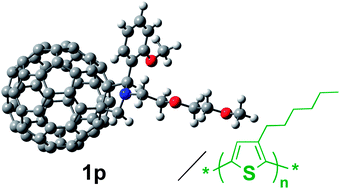Design of fulleropyrrolidine derivatives as an acceptor molecule in a thin layer organic solar cell†
Abstract
A systematic study on the design of

* Corresponding authors
a
Department of Chemistry and Biotechnology, Graduate School of Engineering, Tottori University, 4-101 Koyama-minami, Tottori, Japan
E-mail:
mailto:titoh@chem.tottori-u.ac.jp, titoh@chem.tottori-u.ac.jp
Fax: +81 857 31 5259
Tel: +81 857 31 5259
b
Sumitomo Chemical Co., Ltd., 6 Kitahara, Tsukuba, Japan
Fax: +81 29 864 4748
Tel: +81 29 864 4305
A systematic study on the design of

 Please wait while we load your content...
Something went wrong. Try again?
Please wait while we load your content...
Something went wrong. Try again?
K. Matsumoto, K. Hashimoto, M. Kamo, Y. Uetani, S. Hayase, M. Kawatsura and T. Itoh, J. Mater. Chem., 2010, 20, 9226 DOI: 10.1039/C0JM01565B
To request permission to reproduce material from this article, please go to the Copyright Clearance Center request page.
If you are an author contributing to an RSC publication, you do not need to request permission provided correct acknowledgement is given.
If you are the author of this article, you do not need to request permission to reproduce figures and diagrams provided correct acknowledgement is given. If you want to reproduce the whole article in a third-party publication (excluding your thesis/dissertation for which permission is not required) please go to the Copyright Clearance Center request page.
Read more about how to correctly acknowledge RSC content.
 Fetching data from CrossRef.
Fetching data from CrossRef.
This may take some time to load.
Loading related content
